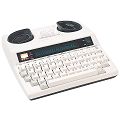
TTY is an acronym for Tele Typewriter, sometimes referred to as a Teletype Machine. As one of the most commonly used accommodations by people who are unable to understand speech on the telephone, teletype machines use text instead of voice to communicate via telephone lines.
TTYs are available with many different features to meet a variety of needs for those requiring assistance hearing or speaking on the telephone. Some utilize standard telephone lines, and others use ASCII to connect to computers with modems. All are compatible with digital wireless networks.
Rehabmart is pleased to present an assortment of superior quality TTY Devices from vendors including Harris Communications, Hearmore, and MaxiAids.
What is a TTY Device?
One of the most commonly used accommodations by people who are unable to understand speech on the telephone, or unable to speak themselves, TTY devices (teletype machines) use text instead of voice for parties to communicate via telephone lines.
On occasion the acronym TDD may appear for the same device. This stands for Telecommunications Device for the Deaf. Today we prefer to describe the TTY device, rather than those who use it. Other names include textphone (common in Europe), and minicom (United Kingdom).
TTY devices are special electronic machines that transmit conversations as text over telephone lines. This allows people who are deaf, hard of hearing or speech-impaired to use the telephone to communicate with those who hear and speak without issues, or with other hearing-impaired individuals. They type messages back and forth to one another instead of talking and listening. TTYs are required at both ends of the conversation.
How do TTY Devices Work?
Teletype machines are about the size of small laptop computers. They generally include a standard keyboard and a small screen that uses LEDs or an LCD display screen to show typed text electronically. Many have small spools of paper and printers incorporated into the device, so that the conversation text can be printed.
It is normally required for the party on each end of a conversation to have a TTY device using a similar communication protocol, such as standard wired telephone service. The telephone handset is placed onto special acoustic cups on the TTY device, the mouthpiece into one cup and the earpiece into another. Some TTY models can be plugged directly into a phone line, and some are usable with cordless and/or portable phones using 2.5mm jacks.
Consumers are now generally able to use TTY devices to complete calls with their digital wireless phones, including 911 calls, if the phone itself is TTY-compatible. To find a TTY-compatible digital wireless phone, contact your wireless service provider or handset retailer.
Once you are connected to your party, type the message you want to send on the TTY device’s keyboard. As you type, the message is sent over the phone line just like your voice would be sent over the phone line if you talked. The TTY device on the other end of the conversation will decode the message for display. The other person’s response will display on your Teletype machine’s text display.
What are some of the limitations of using TTYs?
TTY calls require a good understanding of written language, and a lot of typing. They do not allow for facial expressions, voice inflection, or the many other ways we normally convey information in conversation.
The following tips might help the call go more smoothly if you are conversing with someone you don’t know well, or discussing an unfamiliar topic.
• Use simple language and short sentences.
• Provide only one piece of information at a time. Confirm understanding before proceeding.
• Use pleasantries the same way you would in any phone conversation. “How are you?” “Have a good day” and etc.
Many businesses and individuals do not have teletype machines. To provide TTY users with access to all services accessible by traditional telephone, special Telecommunications Relay Services (TRS) have been developed in every US state and in many other countries.
These relay services allow communication (with the help of a human relay operator) between those who have no difficulty hearing or speaking and individuals who use a TTY device to communicate.
When using the TRS, a special operator types what you say so that the person you are calling can read your words on his or her TTY display. He or she will type back a response, which the TRS operator will read aloud for you to hear over the phone. (Note that the TRS call can originate from either party.)
Toll free TRS services are available 24 hours a day, 365 days a year. Relay calls are kept strictly confidential, by law. You may find your state's toll-free TRS number in the front of your local telephone book.
What Else Is Useful to Know About Using TTY Devices?
To facilitate good communication among those who use TTY devices, a standard communication protocol has developed. Much like modern cell phone language, abbreviations are used to convey information quickly with fewer keystrokes, and to overcome difficulties that arise from the inability to detect when a person has finished “speaking.”
The TTY communication protocol includes:
GA – Go ahead. Indicates the end of your turn, and for the other person to go ahead.
QQGA – Question that you want answered immediately.
GASK – Indicates you have all necessary information and have no more questions.
SKSK – officially ends a TTY call.
BRB – Be right back.
CU – See you (be seeing you).
PLS – Please.
OIC – Oh, I see.
OPR – Operator.
NBR – Number.
TMR –Tomorrow.
THX – Thanks.
WRU – Who are you? Or, Where are You?
XXXX – Xs are often used to indicate a typing error instead of backspacing.
Hulet Smith, OT
Rehabmart Co-Founder & CEO
nrb